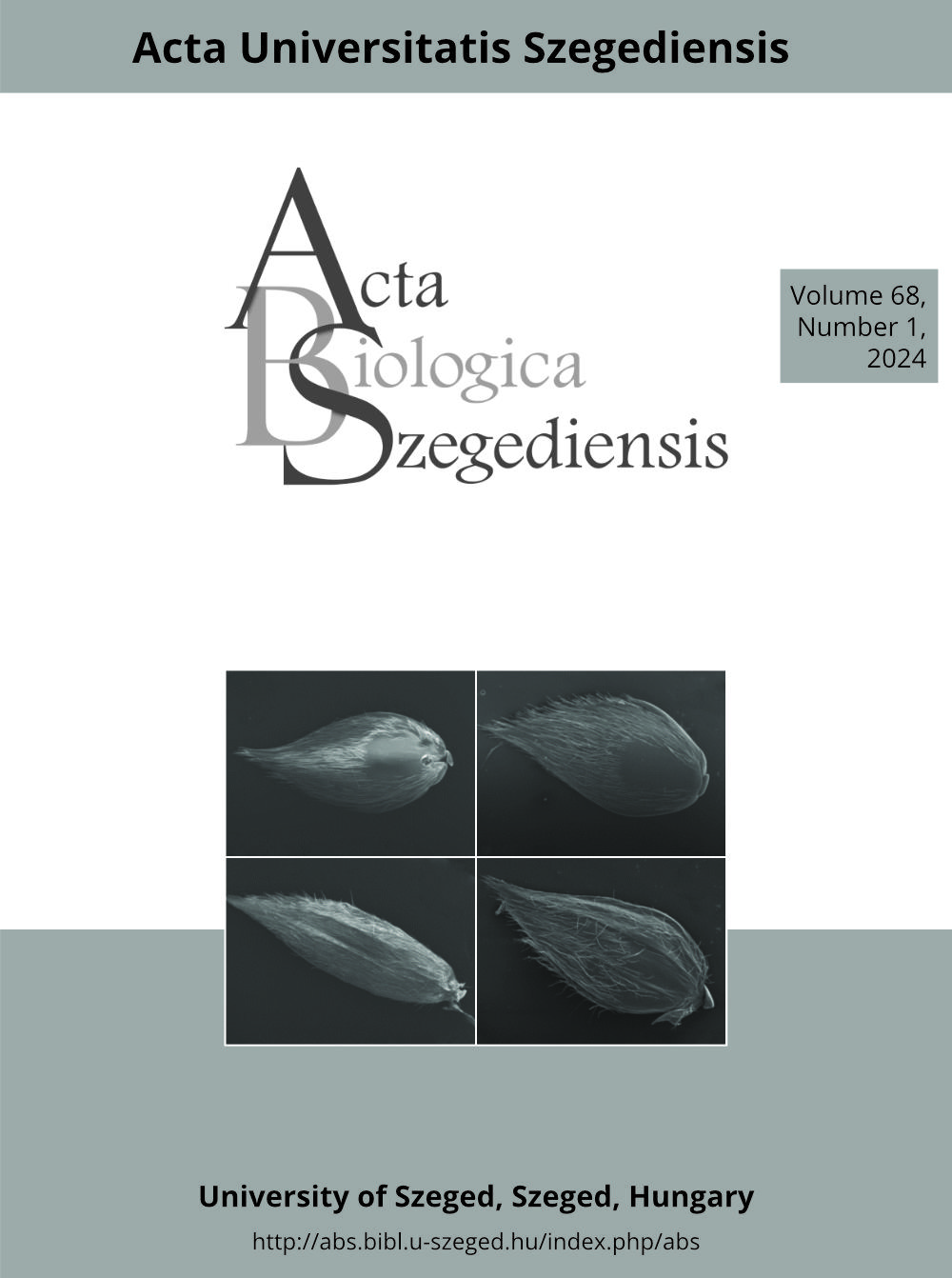Anatomical and micromorphological study of Phalaris (Poaceae) species in Iran
DOI:
https://doi.org/10.14232/abs.2024.1.9-15Keywords:
lemma, micromorphology, palea, Phalaris, PoaceaeAbstract
The genus Phalaris, comprising 18 species globally, has a complex taxonomic history. Species of Phalaris hold significant importance as forage and weeds. Anatomical and micromorphological studies can provide diagnostic traits critical for taxonomy. In this study, we investigated the leaf sheath anatomy and the micromorphology of the lemma and palea to identify distinguishing traits among some Phalaris species in Iran. Twenty-one accessions of three Phalaris species (P. minor, P. brachystachys, and P. paradoxa) from different regions of Iran were studied. Leaf sheath cross-sections were stained using methyl green and Congo red, and both quantitative and qualitative anatomical traits were measured and evaluated. Micromorphological features of the lemma and palea were observed using a Hitachi SU3500 Scanning Electron Microscope. Eleven traits were assessed in the studied species. While the general leaf sheath anatomy showed significant similarities, micromorphological investigations of the lemma and palea epidermis highlighted the palea epidermis, the presence or absence of prickles, and papillae density as key distinguishing features. The findings are consistent with previous studies on this subfamily, enhancing the understanding of Phalaris species taxonomy.
Downloads
References
Acedo C, Llamas F (2001) Variation of micromorphological characters of lemma and palea in the genus Bromus(Poaceae). Ann Bot Fenn 38:1-14.
Aliscioni SS, Ospina JC, Gomiz NE (2016) Morphology and leaf anatomy of Setaria s.l. (Poaceae: Panicoideae: Paniceae) and its taxonomic significance. Plant Sys Evol 302(2):173 -185.
Anderson DE (1961) Taxonomy and Distribution of the Genus Phalaris. Iowa State J Sci 36(1):1-96
Baldini RM (1993) The genus Phalaris L. (Gramineae) in Italy. Webbia 47(1):1-53.
Đenader T, Lakušić D, Kuzmanović N (2020) Variability of leaf blade anatomical traits in the Sesleriajuncifoliacomplex (Poaceae) on the Balkan Peninsula. Phytotaxa 4 42(3):138-152 .
Desai RJ, Raole VM (2013) Foliar micromorphology of subtribe Ischaemineae, tribe Andropogoneae, family Poaceae. Not Sci Biol 5(3):296-302.
Gherekhloo J (2008) Tracing resistant Phalaris minor populations and studying their resistance mechanisms to aryloxyphenoxypropionate herbicides in Fars and Golestan wheat fields. Ph.D. Thesis, Ferdowsi University of Mashhad, Mashhad, Iran [In Persian].
Harms RT, Mendenhall J (2015) Taxonomic utility of lemma micromorphological characters in the Sporoboluscom-positus and Sporobolusvaginiflorus complexes (Poaceae). Lu ndel l ia 18(1):1-9.
Lavergne S, Molofsky J (2004) Reed canary grass (Phalarisarundinacea) as a biological model in the study of plant invasions. Crit Rev Plant Sci 23(5): 415-429.
Liu Q, Zheng DX, Peterson PM (2010) Lemma micro-morphological characters in the Chloridoideae (Poa-ceae) optimized on a molecular phylogeny. S Afr J Bot 76(2):196-209.
Keshavarzi M, Khaksar M, Seifali M (2007) Systematic study of annual weed Phalaris minor Retz. (Poaceae) in Iran. Pak J Biol Sci 10(8):1336-1342.
Keshavarzi M, Khaksar M, Seifali M, Ghadam P (2011) Numerical taxonomy of Phalaris (Poaceae) species based on morphological characteristics. Environ Sci 8(2):29-36.
Kettenring KM, Menuz DR, Mock KE (2019) The nativity and distribution of the cryptic invader Phalaris arundinacea (reed canarygrass) in riparian areas of the Columbia and Missouri River Basins. Wetlands 39:55-66.
Martínez-Sagarra G, Abad P, Devesa JA (2017) Study of the leaf anatomy in cross-section in the Iberian species of Festuca L. (Poaceae) and its systematic significance. PhytoKeys (83):43.
Mavi DÖ, Doğan M, Cabi E (2011) Comparative leaf anatomy of the genus Hordeum L. (Poaceae). Turk J Bot 35(4):357-368.
Mejia-Saules T, Bisby, FA (2003) Silica bodies and hooked papillae in lemmas of Melica species (Gramineae: Pooideae). Bot J Linn Soc 141(4):447-463.
Meng L, Mao P (2013) Micromorphological and anatomical features of four species of Elytrigia Desv. (Poaceae). Bangladesh J Plant Taxon 20(2):135-144.
Olsen JT, Caudle KL, Johnson LC, Baer SG, Maricle BR (2013) Environmental and genetic variation in leaf anatomy among populations of Andropogongerardii (Poaceae) along a precipitation gradient. Am J Bot 100(10):1957-1968.
Ortúňez E, Cano-Ruiz J (2013) Epidermal micromorphology of the genus Festuca L. subgenus Festuca (Poaceae). Plant Sys Evol 299 (8):1471-1483.
Ortúñez E, de la Fuente V (2010) Epidermal micromorphology of the genus Festuca L. (Poaceae) in the Iberian Peninsula. Plant Sys Evol 284(3-4):201-218.
POWO (2024) (Plants of the World Online), Phalaris L. Facilitated by the Royal Botanic Gardens, Kew. Plants of the World Online | Kew Science. (Accessed 18 July 2024).
Shaheen S, Mushtaq Ahmad MA, Farah Khan FK, Muhammad Zafar MZ, Shazia Sultana SS, Khan MA, Leghari MK, Jamil M, Hina Fatima HF (2011) Morpho-palynological and foliar epidermal anatomy of genus CenchrusL. J Med Plants Res 5(16):3796-3802.
Soreng RJ, Peterson PM, Romaschenko K, Davidse G, Teisher JK, Clark LG, Barberá P, Gillespie LJ, Zuloaga FO (2017) A worldwide phylogenetic classification of the Poaceae (Gramineae) II: An update and a comparison of two 2015 classifications. J Sys Evol 55(4), 259-290.
Tabaripour R, Keshavarzi M, Ullah F (2022) Micromorphological characters variation of lemma and palea in subtribe of Loliinae (Poaceae). Microsc Res Tech 8 5 (1) :117-13 4 .
Tkach N, Nobis M, Schneider J, Becher H, Winterfeld G, Jacobs SW, Röser M (2021) Molecular phylogenetics and micromorphology of Australasian Stipeae (Poaceae, sub-family Pooideae), and the interrelation of whole-genome duplication and evolutionary radiations in this grass tribe. Front Plant Sci 11:630788.








